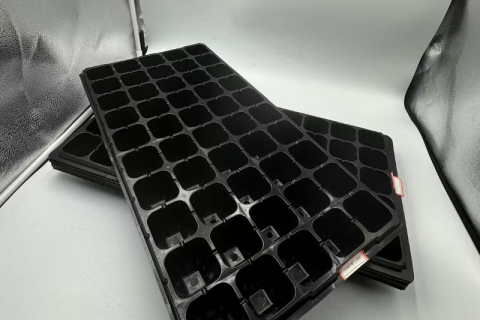
- Home
- >
News
Material: PS TRAY Thickness 0.18mm/customization Size: 530*275*45MM/Customization GRADE: Food grade film color: white/ customization location: china for food tray plant tray
Transparent Pet film, with its unique properties and versatility, has found extensive applications in various industries. In this article, we will explore the uses of transparent Pet film in different fields at room temperature, including blister jewelry packaging, blister tool packaging, blister pharmaceutical packaging, and insulation boards. Through vivid descriptions and real-life examples, we will showcase the importance and advantages of this remarkable material.
An application of the BPET conductive material boosts the electronics industry. August 2024, Shanghai, Global Electronics Manufacturing Exhibition; Zhang Qiang: technical director of a leading electronics materials R&D company. In August 2024, at the Global Electronics Manufacturing Exhibition held in Shanghai, a new type of conductive material took center stage. The Technical Director, Zhang Qiang, of one of the key Electronics Materials R&D enterprises, has brought along with him a team to introduce very latest BPET (Biaxially Oriented Polyethylene Terephthalate) conductive material. This launch marks the large step forward applying static protection and conductive materials within the electronics industry. Background: Help Needed to Meet Increased Demand for Static Protection With their ever-growing sophistication and complication, electronic products are also requiring more dependable static protection and conductive materials. Having noticed this emerging market demand, Zhang Qiang and his group embarked on a multi-year development program in search of creating a high-performance material to satisfy the demand. "We all noticed that all kinds of conductive materials available in the market had a number of problems, such as low transparency and unstable conductivity, which limited their usage in high-end electronic devices," Zhang Qiang explained during the launch. "It is this that moved us to develop a material that links high transparency, brightness, and stable conductive performance to serve the industry much better." Process: Overcoming Technical Challenges and Enhancing Performance The BPET material is produced with the help of imported production lines to ensure high transparency, brightness, and crystal-free surfaces with excellent flatness. Food grade slip agents were added by the team into the material to give it excellent surface smoothness, good processability, and well-preserved conductive properties. BPET sheets come in various specifications, thereby allowing for high production capacity at superior quality and cost-effectiveness. This is an environment-friendly and non-toxic material that meets QS food safety certification and passes the European Union's SGS environmental certification, hence suitable for industries with strict compliance criteria to safety and the environment. The following are several conductive grades for the materials: - Permanent Conductive Sheet: $10^10$ ohms - Permanent Antistatic Sheet: 10^10 ohms - Permanent Semi-Conductive Sheet: 10^6-10^9 ohms These variations show steady and smooth conductive performance, which ensures the stability and reliability of products for various applications. Besides, BPET can be processed into flat sheets, slit, and laminated; while PET-G and GAG grades are especially suitable for producing high-end electronic products. Result: Good Market Response and Wide Industrial Application In the exhibition, BPET conductive material was very fast.
Polystyrene in Seedling Trays and Food Containers: An Overview of its Role Date: 8th August 2023 Location: Global Key Figures: Environmentalists, Industry Experts, Policymakers Introduction 8th August 2024 is the day that saw a heated, highly perceived argument of the use of Polystyrene commonly abbreviated as PS in the making of growing seedling trays and food containers. The debate borders on the balance between the practical usefulness of PS and its effect on the surrounding environment. Background Sand used to be the raw material for the production of polystyrene, which is a very wide applied plastic because of its cost-effectiveness and versatility in application. In horticulture, PS is used for seedling trays so that they can give their supporting plant effective drainage and serve a longer time due to their strength. In the food service sector, PS is used for containers like clamshells and cups due to its insulative and affordable properties. Events Horticulture Sector: Environmentalists in the previous decades have already raised concern on the future environmental impacts of PS seedling trays. Although the trays are durable and even to some extent, are reusable, these trays still add to plastic pollution because they are non-biodegradable. Other areas have already explored alternative materials to reduce plastic waste on gardening refuse. Food Service Sector In the same vein, the food service sector has been pressured by the public to discontinue its heavy use of PS containers. While the reasons behind this popularity are insulation and cost reduction, they have been faulted for contributing to the volume of landfill sites and being potential health risks. Recent reports have shown the need to shift to biodegradable packaging systems. Findings Plan Response from Industry: Going Green. In response to these perceptions, the horticulture and food service industries have began to react to the environmental impact of PS. These key steps include, 1. Alternatives: Research over biodegradable and compostable alternatives has been expedited. Industries now look into materials like plant based plastics and recycled fibers that can substitute common PS. 2. Developed Recycling Programs: Advanced recycling infrastructure is developed to manage a better waste load from PS. Developed recycling technologies and programs are being introduced to recover and reutilize materials made from PS. 3. Policy Change: Many countries' governments have framed regulations to control and limit the use of PS in single-use products. The policies have been framed to promote and encourage the use of sustainable alternatives and improve the management of waste. Impact And, the following are some of the positive impacts that the global response to the PS issues resulted in: Increased Awareness: Increased awareness among consumers and industry-related people about the environmental effects of PS and their role has facilitated informed choices and practices. Developing New Materials: The search and, to a contrary, immediate need for alternative sustainable gear had resulted in developing new eco-friendly types of materials in place of the traditional PS used in the nursery trays and food containers. - Advancements in Policies and Regulations: New policies and regulations enable changes toward sustainable operations directed to horticulture and foodservice sectors. Conclusion The ongoing discussion of the role of Polystyrene in seedling trays and food containers really brings the point of balancing practical advantages with environmental responsibility. The work on these challenges has been attended to, in developing partnership with industry and government, while the focus is on sustainability and being innovative with the future of eco-friendliness in both gardening and food service.
Durability: ABS sheets are highly resistant to impact and very tough, hence ensuring that the conductive panels undertake physical stress and other related harsh environments.
1. Manufacturers: Companies like Coca-Cola, Nestlé, Toyota, and BMW. 2. Engineers and Architects: Construction professionals who believe in sustainability. 3. Researchers and Developers: Inventing better properties and uses for PET. Events: 1. The shift to PET bottles for beverage companies. 2. Additional applications of PET in automotive components. 3. Use of PET in construction for insulation and durable components.
Innovative Use of Polycarbonate Sheets Transforms Sunrooms in Shanghai Shanghai, China – July 29, 2024 – The latest wave in home renovation has just hit the cosmopolitan city of Shanghai, as more and more people are using polycarbonate (PC) sheets to renovate their sunrooms. Invented to revolutionize the way sunrooms and other house extensions are designed and built, this innovative material gives the best combination of aesthetics, durability, and energy efficiency. Pioneering Project in Xuhui District Recently, another outstanding example of this tendency is the renovation of a sunroom with polycarbonate sheets that Ms. Li Wei from Xuhui District has just completed. The project began in early May and was completed in mid-July, revealing to people the magic of PC sheets in renovating a house. Key Participants and Their Roles Renovation work was led by well-known Shanghai architect Mr. Zhang Jian, who mainly works with sustainable and innovative building materials. Mr. Zhang worked on the design of the sunroom together with Ms. Li, trying to increase both the aesthetic value of her house and natural lighting for improved energy efficiency. Outstanding Results It has newly renovated sunrooms with transparent, high-quality polycarbonate sheets that allow a lot of sunlight into the space while filtering dangerous UV rays to ensure the interior is bright and airy, making it perfect for relaxation and leisure. The PC sheets have improved the thermal insulation drastically, enhancing the sunroom's energy efficiency and thus able to maintain comfortable temperatures throughout the year with very minimal heating or cooling systems. Ms. Li expressed satisfaction with the results and said, "The polycarbonate sheets have renovated my sunroom into a beautiful and practical place. I was impressed by how fast and efficient the renovation was. The room has become the most favorite part of the house; it is full of natural light and very comfortable during summers and winters. Broadening Horizons He added that the application of polycarbonate sheets in renovation projects meant much more than them simply being used. "Indeed, polycarbonate sheets are versatile and solid. Lightweight, easy to install, and well-insulated, they turn out to be the perfect material for any other kinds of works related to sunrooms, greenhouses, patio covers, and interior partitions." Community Impact and Future Prospects The result of the sunroom renovation project for Ms. Li has piqued the interest of all her neighbors and the greater community. Now, more than a few homeowners in the Xuhui District are considering doing similar projects after getting inspired by the beauty and functionality showcased in Ms. Li's home. In the future, Mr. Zhang will continue to promote the use of polycarbonate sheets in building renovations. He actually has been negotiating with several clients regarding the use of PC sheets in their upcoming projects. "I firmly believe that this material will have been installed in most of the buildings in the near future where green construction methods will be implemented," he said. "Its advantages are obvious, and I look forward to more house owners taking advantage of this new solution." Conclusion The use of polycarbonate sheets in sunroom renovations is raising a new bar of excellence in home improvements within Shanghai. With pioneers like Ms. Li and visionary architects such as Mr. Zhang at the helm of this emerging trend, it is only bound to pick up in pace, bringing about a modern, efficient, and visually effective successor to traditional building materials for homeowners.












